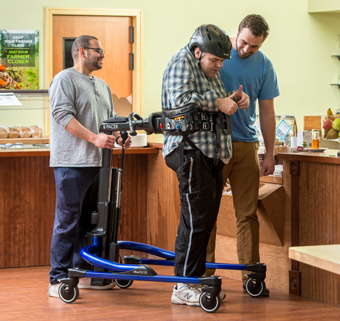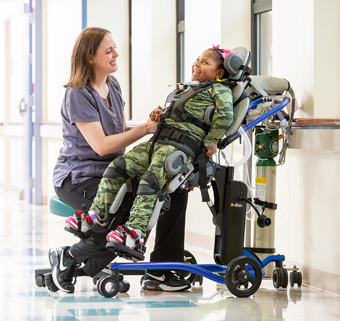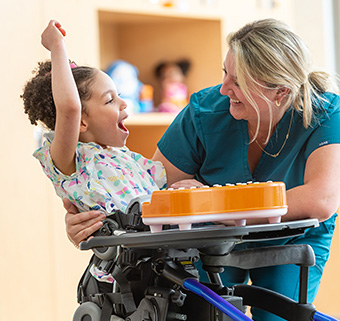Encouraging Participation-Based Goals in the School Setting
| January 2019 Physical therapy goals in the school-based practice setting can focus on a variety of areas, including: participation (student’s involvement in a life situation), activity (student’s execution of a task or action) and impairment (i.e. at the level of body structure and function.) For a number of reasons we find that student goals that address participation within the context of school routines are not universally used. But it is just these participation-focused goals that are most aligned with federal legislation and professional guidelines. In fact, education-based related services are mandated to support student participation in their educational program. (1) (2)
Physical therapy goals in the school-based practice setting can focus on a variety of areas, including: participation (student’s involvement in a life situation), activity (student’s execution of a task or action) and impairment (i.e. at the level of body structure and function.) For a number of reasons we find that student goals that address participation within the context of school routines are not universally used. But it is just these participation-focused goals that are most aligned with federal legislation and professional guidelines. In fact, education-based related services are mandated to support student participation in their educational program. (1) (2)
I attended an interesting course last November at APPTAC 2018, titled “Developing and Using Goals for Students’ Meaningful Participation in School: A Complex Process.” The two speakers, Kimberly Wynarczuk, PT, DPT, PCS, MPH, CHES who is an assistant professor at Kean University, and Lisa Chiarello, PT, PhD, FAPTA who is a professor at Drexel University, presented findings from their recently conducted and original research. (3) (4) This effort was a follow-up to the PT COUNTS study, that occurred during the 2012 -2013 school year, and which looked at the outcomes achieved by 296 students with disabilities from 26 states who were receiving school-based physical therapy over a period of six months.
The presenters showed findings from a follow-up study, conducted between October and December 2015, that involved a questionnaire distributed to the same 111 school-based PTs from the original PT COUNTS study; 46 PTs completed the questionnaire. Their findings were interesting.
For example, here’s the percentage of the responding PTs who reported that they wrote goals that focused on these areas:
- Participation (96%)
- Activity limitations (87%)
- Impairments (36%)
The researchers also looked at what may facilitate and what may be a barrier to developing and using student goals that address participation in school. The data enabled the researchers to consider this question: What is the best way to develop student goals?
To conclude their presentation, the speakers provided a useful tool that school-based physical therapists can use to guide development of participation-based goals. (6) These five important points were identified.
1. “The G in GOALS is for Get to Know the Student”
To UNDERSTAND THE STUDENT involves observing the student in all settings throughout their school day, during specific activities, routines, and tasks. Where applicable, assessment tools such as the School Function Assessment (SFA) (5) are used to identify the student’s strengths and weaknesses. Strengths and needs may include the student’s personal factors such as personality, preferences, behavior, and family background, as well as the relevant physical or bodily findings. It is also essential to consider the student’s school environment. With understanding, it is possible to build an interpersonal connection both with the student and with those who relate with the student throughout the day.
2. “The O in GOALS is for Organize the Team”
TEAMING is a key part of the therapist’s role, and involves identifying the key members of the educational team and acknowledging each member’s expertise. Recognizing the roles of the student, parents, teachers, and related service providers will help to establish communication and trust. Information sharing between related service providers allows team members to call on each member’s specialized knowledge, skills, and experience. This in turn will further develop collaboration and a shared sense of responsibility for goals that integrate more than one particular discipline. Communication is prioritized by determining individual communication preferences, best times for in-person consultation, and best times for team meetings. Online collaboration tools such as Google Docs or Google Hangouts can be a great way for effective communication when in-person meetings are a challenge to schedule.
3. “The A in GOALS is for Address what is Relevant”
FOCUS on educational relevance is essential. The team will identify needs that are relevant to the student’s day. Participation will necessarily involve accessibility, the student’s daily routine, and peer-related opportunities as well as transition-related concerns for the student’s needs in higher grade levels and beyond. Identifying the student’s priority needs that require goals will also assure natural opportunities for the student’s meaningful participation in school and daily practice of the goal. To quote a 2003 study, “if the skill cannot be observed or measured during the child's normal school day, it might not be relevant to that child's education.” (7)
4. “The L in GOALS is for Learn and Adopt Best Practices.”
BEST PRACTICES are the recommendations from federal, state, and local guidelines. School-based therapists will strive for continual professional development, identifying opportunities for continuing education in evidence-based practice, and identify and learn from key mentors who utilize best practices.
5. “The S in GOALS is for Structure the Goal”
Finally, to actually DEVELOP AND WRITE THE GOAL will require an investment of time and effort and ongoing reflection on goal development. It is important to identify the student’s priority needs before developing specific goals, and then to ensure that the goal is worded to reflect the student’s participation. This means that the goal both specifies and will be addressed through (and measured within) a school activity or routine. Each goal is SMART: specific, measureable, achievable, relevant, and time-based.
(1) Individuals with Disabilities Education Act (IDEA), Pub. L. No. 108-446 (2004.) https://www.copyright.gov/legislation/pl108-446.pdf [Find (26) Related Services.]
(2) McEwen, I. R. (Ed.) (2009) Providing physical therapy services under parts B & C of the individuals with disabilities education act (IDEA) (2nd ed.) Section on Pediatrics, American Physical Therapy Association. Available at: https://iweb.apta.org/Purchase/ProductDetail.aspx?Product_code=PEDS-4
(3) Wynarczuk, K.D., Chiarello, L.A, and Gohrband, C.L. (2017) Goal development practices of physical therapists working in educational environments. Physical & Occupational Therapy in Pediatrics. 37(4):425-443. doi 10.1080/01942638.2017.1290009
(4) Wynarczuk, K.D., Chiarello L.A., Fisher K., Effgen S.K., Palisano R.J., and Gracely E.J. (2019) School-based physical therapists’ experiences and perceptions of how student goals influence services and outcomes. Physical & Occupational Therapy in Pediatrics. DOI: 10.1080/01942638.2018.1546254 Published online: 15 Jan 2019
(5) Coster WJ, Deeney TA, Haltiwanger JT, & Haley, SM. (1998). School Function Assessment. San Antonio, TX: Psychological Corporation/Therapy Skill Builders. Available at: https://www.pearsonclinical.com/ Overview: https://images.pearsonclinical.com/images/assets/SFA/SFAOverview.pdf
(6) Wynarczuk, K. D., & Chiarello, L. A. (2018). G.O.A.L.S. for student participation infographic. Retrieved from https://www.uky.edu/chs/academic-programs/department-rehabilitation-sciences/physical-therapy/pt-counts
(7) Dole, R. L, Arvidson, K., Byrne, I., Robbins, J., and Schasberger, B. (2003) Consensus among experts in pediatric occupational and physical therapy on elements of individualized education programs. Pediatric Physical Therapy. 15(3):259-166. Free Full Text: https://journals.lww.com/pedpt/Fulltext/2003/01530/Consensus_Among_Experts_in_Pediatric_Occupational.4.aspx




